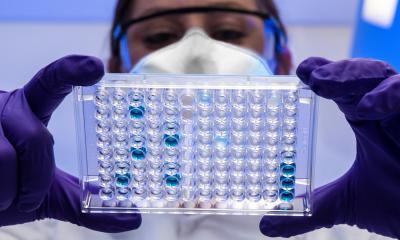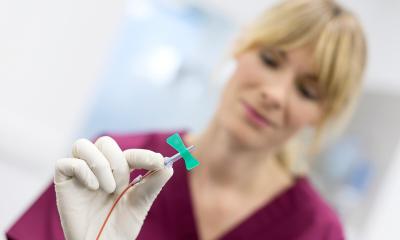Reading the changing face of lab medicine
The 24th International Symposium of the AACC Critical & Point of Care Testing Division. Report: Michael Reiter

According to Dr Ian Watson, President of the European Federation of Clinical Chemistry and Laboratory Medicine (EFLM), roughly 70% of medical interventions require a lab test, underlining the importance of the clinical laboratory in the care chain. Laboratory medicine covers a broad spectrum, from identifying heart attacks to testing for diabetes and cancer, he adds. Indeed, major trends are now transforming this relevant field – a clear message from the 24th International Symposium of the AACC Critical & Point of Care Testing Division this October.
The genomics impact Genomics is beginning to exert a major influence. Deep sequencing is providing detailed information about an individual’s DNA, shedding light on individual risk for certain diseases and the capability of metabolising specific drugs. Treatment personalisation through genomics is happening now, Dr Watson said, in Prague, ‘… and proteomics provides a further step in understanding why there are, for a given disease, different abnormalities in different individuals in different tumours, and why they respond differently to a therapeutic approach’.
Changes in lab organisation Laboratories tend to be centralised facilities. Many devices are becoming sufficiently sophisticated today to eliminate the need of sending samples to a lab – ‘quite important tests can now be done at the point of care (POC), in the ward or outside hospitals. This helps speed up processes; the downside is that properly trained staff are required at the site and results need to be fed into the patient record,’ the EFLM President pointed out. In an increasing number of cases it is the patient, not the healthcare professional, who receives test results. With mounting adoption of those devices and connections available via the Internet, ‘why shouldn’t, for example, a diabetic receive his lab results, or medical record, on his or her smartphone?’ he questioned. ‘If you need to get your HbA1c measured every three months, should you need to go to the hospital or GP surgery to have this done? I don’t see why educated chronically ill patients shouldn’t contact a lab directly for that, with the result being sent both to the doctor and patient directly.’
Dr Watson went on to describe the case of a female kidney transplant patient who herself monitors kidney function. Whilst central laboratory testing will maintain its key position in diagnostics, upon leaving the hospital and after receiving training by hospital staff, the patient The 24th International Symposium of the AACC Critical & Point of Care Testing Division may continue monitoring using a POC test, with results also transmitted to the doctor in charge. As in the self-monitoring kidney case, this approach helps reassure patients and also keeps the physician informed to avoid risks; i.e. when results deviate from pre-set parameters, the patient will go to hospital. Other patients monitor their own warfarin dosing, Dr Watson said, adding that more sophisticated tests are in the pipeline.
Communication The knowledge management aspect of what laboratory medicine offers is ever more significant. In countries where there is an integrated laboratory service between hospitals and primary care, as in the UK, results are discussed and interpreted by specialists in laboratory medicine along with physicians from both sides; technical service delivery is becoming less important. ‘A more patient-centric approach would possibly include information on the results in lay language as well,’ the EFLM President suggested.
Already, 68 million lab tests are made available by phone apps to patients within Kaiser Permanente, a major USA hospital management organisation (HMO). According to Dr Watson, this underscores the clear trend of communicating medical information to patients. Lab Tests Online is a helpful website to enhance understanding of medical information for a broader audience. For professionals, applications are emerging that interpret results automatically and deliver a first shot, helping professionals interpret test results – e.g. for thyroid function, e.g. ‘after T4 replacement, with TSH suppressed, probably over-replaced, consider changing dose and check results in three weeks’. Another trend is towards POC tests being performed in community health centres by trained technicians, with results transmitted to hospital physicians for reporting.
Equipment and diagnostic services The development is occurring worldwide – lab equipment and tests are consolidating through large comprehensive suites that improve technical efficiency, although highly competent staff will be needed to deliver clinical aspects of the service. As far as diagnostic services are concerned, public labs are being privatised in several countries, with the more sophisticated, costly tests done in hospital labs.
Standardisation initiatives A lack of standardisation regarding units expressing concentration is still making it difficult to work across borders, said Dr Watson. Initiatives aiming at standardisation and harmonisation are driven by a number of international organisations, including EFLM as well as the American Association for Clinical Chemistry (AACC). Another EFLM campaign is driving for recognition of appropriately trained non-medical staff qualifications across Europe. However, some national laws make this difficult. Eur. Clin.Chem, a register open to medical and appropriately trained and qualified laboratory science professionals, provides a basis for recognition of qualification levels.
Recognition of the profession is hampered by a variety of terminologies resulting in practitioners choosing to describe themselves as Specialists in Laboratory Medicine. ‘A survey, conducted in 39 countries, aimed at describing the qualifications, achievements, and tasks of a specialist in laboratory medicine – we changed our society’s abbreviation from EFCC to EFLM in accordance with the results,’ Dr Watson explained. In the future, all of the developments described above should facilitate the development of the profession at local, regional and international levels.
PROFILE
Dr Ian Watson, Clinical Director of Laboratories at University Hospital Aintree, Liverpool, UK and Past-President of the International Association of Therapeutic Drug Monitoring and Clinical Toxicology, Past-Chair & President of the Association for Clinical Biochemistry, and President of the European Federation of Clinical Chemistry and Laboratory Medicine (EFLM)
12.11.2012











